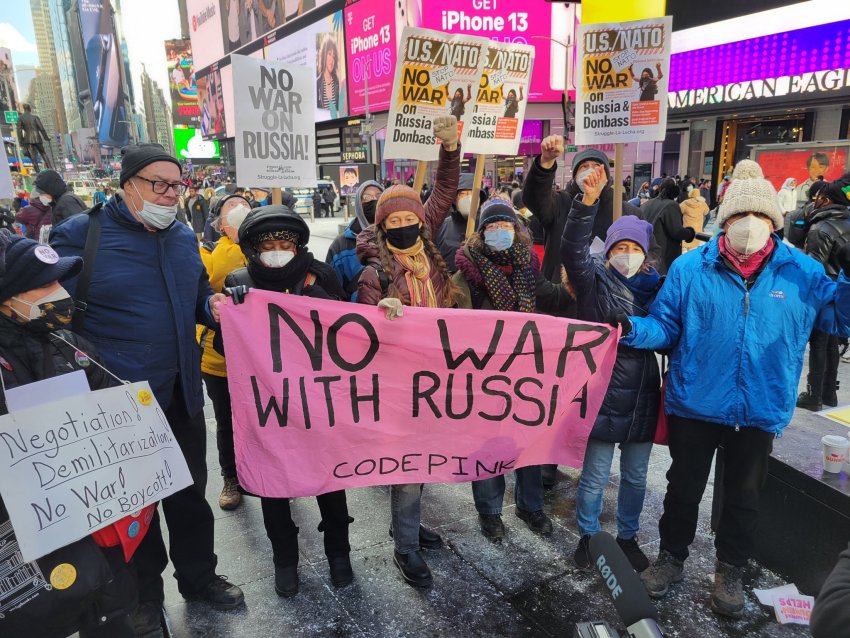
During the 2014 Maidan demonstrations — named after the main square in Ukraine’s capital Kyiv where they were staged — brief footage appeared of an armed fascist group located on a balcony overlooking the protest.
The group displayed a United States confederate flag and another flag resembling that of a Ukrainian military group that joined forces with the Nazis to fight the Soviet Union during World War II.
Since that brief shot appeared, the US media has avoided discussing the role of armed fascist organisations in Ukraine — including their spearheading of the 2015 Ukrainian war against the largely Russian-speaking east of the country — until an article appeared in The New York Times on February 11.
The article admitted that the groups “represent a potent political force in Ukraine”, but carefully avoided using the word “fascist” to describe them.
It began: “The Ukrainian political activist and militia member sat before his party’s flag, leaving little doubt about his readiness for action. The flag depicted two axes crossed against a field of red.
“Yes, Yuri Hudymenko said, he is ready to take up arms, but not necessarily against Russia. As the leader of Democratic Ax — one of dozens of right-wing or nationalist groups [under the name of the Right Sector] that represent a potent political force in Ukraine and are fiercely opposed to any compromise with Moscow — his anger will be directed at Ukraine’s government if it grants too many concessions in exchange for peace.
“We’ll deal with Russia one way or another later,” Hudymenko told the NYT.
“If anybody from the Ukrainian government tries to sign such a document, a million people will take to the streets and that government will cease being the government.”
The “document” Hudymenko was referring to is the 2015 Minsk Agreement — named after the Belarus capital where it was negotiated. The main point of the accord, which Germany and France helped negotiate, was to solve the question of the Donbas region in south-east Ukraine by bringing the Donetsk and Luhansk People’s Republics, supported by Russia, into a federated Ukraine.
On that basis, there would be guarantees of equal rights, etc.
Ukrainian nationalists, backed by the US, rejected the accord.
Russian president Vladimir Putin has now proposed it should be the basis of a settlement.
The NYT reported that, according to records released from his phone call with Putin, French President Emmanuel Macron and the Russian leader discussed “ways of moving forward” with implementing the 2015 peace plan for eastern Ukraine and had continued talks over the “conditions of security and stability in Europe”.
Another “document” France has raised, according to the NYT, is a proposal for Ukraine to be neutral on the question of NATO and Russia.
The US rejects both proposals out of hand.
According to the NYT, because of the threats from armed far-right groups, “analysts” are saying that Ukrainian president Volodymyr Zelensky “would be taking extreme political risks even to entertain a peace deal, which why he is so careful not to talk about possible avenues for negotiation”.
Oleksandr Ivonov, director of the fascist Movement Against Capitulation also told the NYT: “Macron wants to sacrifice Ukraine’s sovereignty to calm Russia down, but doesn’t understand that it will not work.
“Diplomats do not understand Ukraine,” said Ivanov.
“Civil society here has a bigger influence on politics than actual political parties … For Mr Zelensky the threat of war is only a threat, while signing compromises is guaranteed to bring protests.”
“Zelensky and his government may be under pressure from both Ukrainians and Russia,” Hudymenko told the NYT on February 11, but “they fear the Ukrainian people more than they fear the Russian army”.
Ivanov’s group staged a demonstration in Kyiv of “thousands” on February 12 against any compromise with Russia.
The US has stepped up supplying arms to these “Right Sector” groups, claiming they will be the “civilian resistance” to a Russian invasion.
Meanwhile, the White House issued another hysterical report, on February 11, saying it was convinced that Russia would “soon invade”, in hours, a day, two days, or maybe “during the Olympic Games”.
This is a repeat of many such claims of imminent Russian invasion of Ukraine the US has made since last November, without disclosing — “in the interests of national security” — any evidence to support such claims.
CNN and the other pro-war media have gone into a frenzy.
Biden’s greatest fear is that Russia just sits pat — does not invade, but keeps its troops at its own borders (and perhaps in Belarus within its borders) — while divisions within NATO grow, and the world goes weary of claims of imminent invasion.
This could lead the White House to do something dangerous in desperation. The “false flag” provocation that Washington says Moscow will take to justify an invasion may well be imitated by the Pentagon, to impose massive sanctions against Russia, for example.